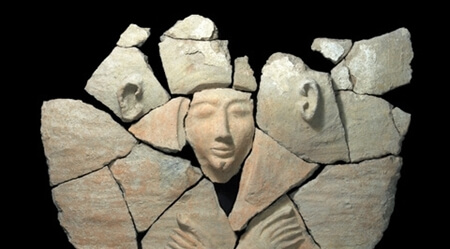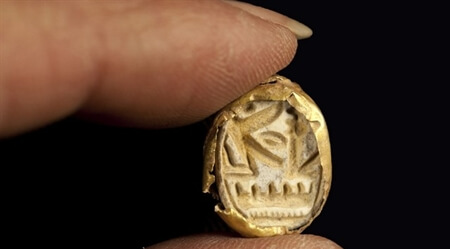Archeological excavations that began after the laying of a gas pipeline in the north, led to the sensational discovery of a tomb, apparently containing a Canaanite official who served in the Egyptian army. A gold signet ring was discovered in the tomb with the name of King Seti I who was the father of Ramses II

A 3300-year-old coffin, containing personal belongings of Amid Canaan, who may have been an official in the Egyptian army, was uncovered during excavations by the Antiquities Authority near Tel Shadod, in the northern Jezreel Valley.
"During the excavation, we discovered a unique and rare find, a cylindrical pottery coffin with a lid designed in the shape of a man, around which a variety of pottery was found, mainly food storage vessels, tableware, ritual vessels and animal bones," said the excavation's directors, Dr. Edwin Van Dan Brink, Dan Kirzner and Dr. Ron Barry.
The researchers also added that "it seems that all the vessels that were buried together with the man were used, according to custom, as offerings to the gods, and were also intended to provide food for the dead after their death." In addition, they noted that "a person from the settlement could not afford to order such a coffin and without a doubt it is a person buried who belonged to the local elite".
A rare find found next to the skeleton is an Egyptian seal scarab with a gold shell attached to the ring. The scarab was used to sign documents and objects. In the seal appears the name of the crown of King Seti I, who ruled ancient Egypt in the 13th century BC. Seti I was the father of Ramses II, identified by some scholars with the Pharaoh mentioned in the Book of Exodus in the story of the Exodus.

In the seal you can clearly see the winged Oreus (cobra snake) protecting the king's name, or the king himself. The mention of King Sethi on top of the scarab found in the coffin helped the researchers to date the time of the tomb to the 13th century BCE - similar to the tombs found in Deir al-Balah and Beit Shan, which were Egyptian administrative centers.
The excavation at the site began from the beginning as an archeological rescue excavation, after the discovery was made as part of a project by the Israel Natural Gas Routes Company (NTGAZ) to establish a main pipeline line for transporting natural gas to Ramat Gabriel.
The excavation of the entire site was completed and the site was covered and the findings were transferred to the laboratories of the Jerusalem Antiquities Authority. The Antiquities Authority is now investigating the possibility of taking a DNA sample from the grave, in order to check whether the deceased was originally Canaanite, or an Egyptian person, who was buried in the land of Canaan.
